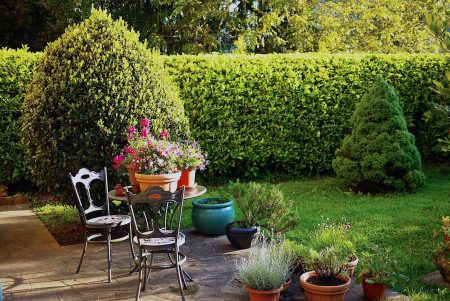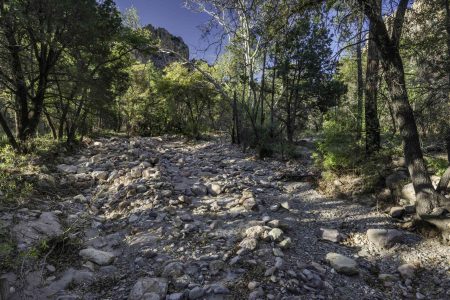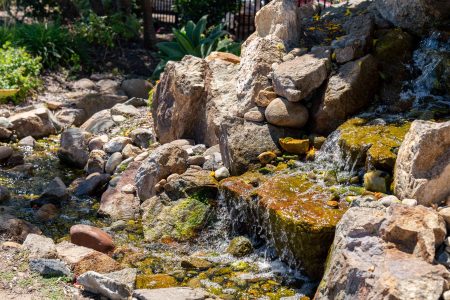When you look at your neighbor’s yard, perhaps you say, “The grass is always greener on the other side.” Well, don’t despair. If you check for excessive thatch, water sufficiently, mow correctly, test the soil, and use lawn fertilizers properly, the grass will be greener on both sides of the fence (and maybe even a little greener on your side).
Deal With Thatch
Thatch is a naturally occurring layer of primarily dead grass that lies on top of the soil of your lawn. It comprises undecomposed stems, stolons, rhizomes, and roots. If the thatch layer is more than 1/2 inch thick, it can be unhealthy for your grass and should be removed through a process called dethatching.
If your lawn’s thatch buildup is right around 1/2 inch, you have a minor lawn thatch problem that is relatively easy to deal with. A thick layer (3/4 inch or more) calls for a core aerator or a vertical mower. Both can be rented from your local rental center.
Give Adequate Water
What’s the yearly rainfall to be expected in your region? In dry climates, an irrigation system is necessary for growing grass successfully. But, in the misty Pacific Northwest, it is understandable if you choose to let Mother Nature do the watering.
Cost is often a primary factor when considering an irrigation system but keep in mind that, in the long run, an irrigation system may save you money because it is more efficient than other ways of watering.
Whichever method you choose, your grass must have enough water consistently to remain green and healthy. While overwatering can lead to its problems, an under-watered lawn lacks the vigor and resilience to compete with weeds and diseases, not to mention staying green.
In mid-summer, drought and insect activity are two of the greatest enemies of your grass.
Feed to Control Weeds
We know we have to fertilize the tomato plants in our gardens or the houseplants on our window sills. But it’s easy to overlook the necessity of spreading fertilizers over our grass. Perhaps it is because the individual grass plants work in unison, together forming something we know as “the lawn.” But it’s more accurate to think of a lawn as millions of individual plants that must be fed regularly.
Fertilizing your lawn goes hand-in-hand with lawn weed control. As your grass takes in the fertilizer’s nutrients, its root system will expand and cover any bare spots. Weed seeds count on those bare spots to take hold. When you remove those spots, you’re reducing the potential for weeds. Ideally, thanks to your fertilizing and other maintenance efforts, you’ll get to a point where your grass is so healthy that it crowds out most weeds.
You may also opt to feed your grass and control weeds simultaneously, using a “weed and feed” fertilizer, food for grass, and poison for weeds. Remember that these fertilizers are not organic and can typically be applied only twice a year.
Test Your Soil
- Check your soil’s pH to make sure it is not too acidic or if it has enough acid content.
- You can check pH with kitchen supplies, soil testing strips, or a pH meter
- Grass should be slightly acidic, trending toward neutral (6.5-7.0).
- A pH imbalance can affect a plant’s ability to absorb nutrients. All the fertilizer in the world will be meaningless if a wrong pH shuts off a plant’s ability to feed.
Follow a Fertilizer Schedule
Apply in Stages
Scotts, a major fertilizer manufacturer, recommends applying lawn fertilizers in four stages. The exact dates will vary from region to region. Another factor is the kind of grass you grow. So always read the package labels carefully before applying, and pick the brains of the staff at local garden centers or local extension services.
As an example of a typical fertilizer schedule, if you live in the northeastern United States and your lawn is a mix of cool-season grasses, you might begin by feeding the grass in May with a product that contains a pre-emergent herbicide to prevent crabgrass from growing.
Follow that up in June with another lawn fertilizer that performs two jobs simultaneously—fertilizing and controlling broad-leaved weeds. For the latter, you need a product that contains a post-emergent herbicide designed to kill weeds that have begun growing in your lawn.
Winterize Your Lawn
Last but not least, don’t forget your grass when you winterize your yard in autumn. It’s not difficult to remember which fertilizers to shop for now because they contain “winterizer” in the product name. These products help your grass build a deeper root system to weather the winter. Closely study the label of a winterizer bag before buying to learn the NPK content or nitrogen-phosphorous-potassium ratio.
In “The Myth of “Winterizer” Fertilizer,” Robert Cox, Cooperative Extension Agent for Colorado State University, warns that lawn fertilizers will fail to enhance the winter hardiness of your grass unless they are sufficiently high in nitrogen. Suggesting using a fertilizer with an NPK of 25-5-5 (or thereabouts), Cox goes so far as to state, “Nitrogen applied in the fall is the most important lawn fertilization of the year.”
Use Compost
For those who prefer to landscape organically, applications of compost will be the answer (or at least a big part). Keeping your grass well-fed with compost has a better chance of crowding weeds out (and avoiding pest invasions, too).
You’ll have to resort to good, old-fashioned hand-pulling to practice organic lawn-weed control on the weeds that do emerge. If you choose this route, water the area first since weeds come out of wet soil more easily than out of the dry ground.
Mow at the Right Height
According to the Cornell University Cooperative Extension, cutting the lawn with a mower set at a proper height can save you from having to bag your grass clippings, even if you don’t own a mulching mower. The rule of thumb suggested by the Cornell Extension is, “Mow when your grass is dry and 3 to 3-1/2 inches tall. Never cut it shorter than 2 to 2-1/2 inches or remove more than one-third of the leaf surface at any one mowing.”
Cutting only an inch at a time means more frequent cutting, and you’ll have to sharpen your mower blade more often. But the result is a healthier lawn fed by nutrients you would otherwise be hauling away. Cutting the lawn (similar to “pinching” other garden plants) stimulates growth, increases thickness, and makes the grass sturdier. It’s also not good to cut your lawn too short since it can stress it out, especially during hot weather.
Note that with mulching mowers, you don’t need to be quite so careful about the height at which you cut the lawn since the grass clippings are shredded up more finely. This works much better for those who don’t generally walk around with measuring tape.
Read the full article here









